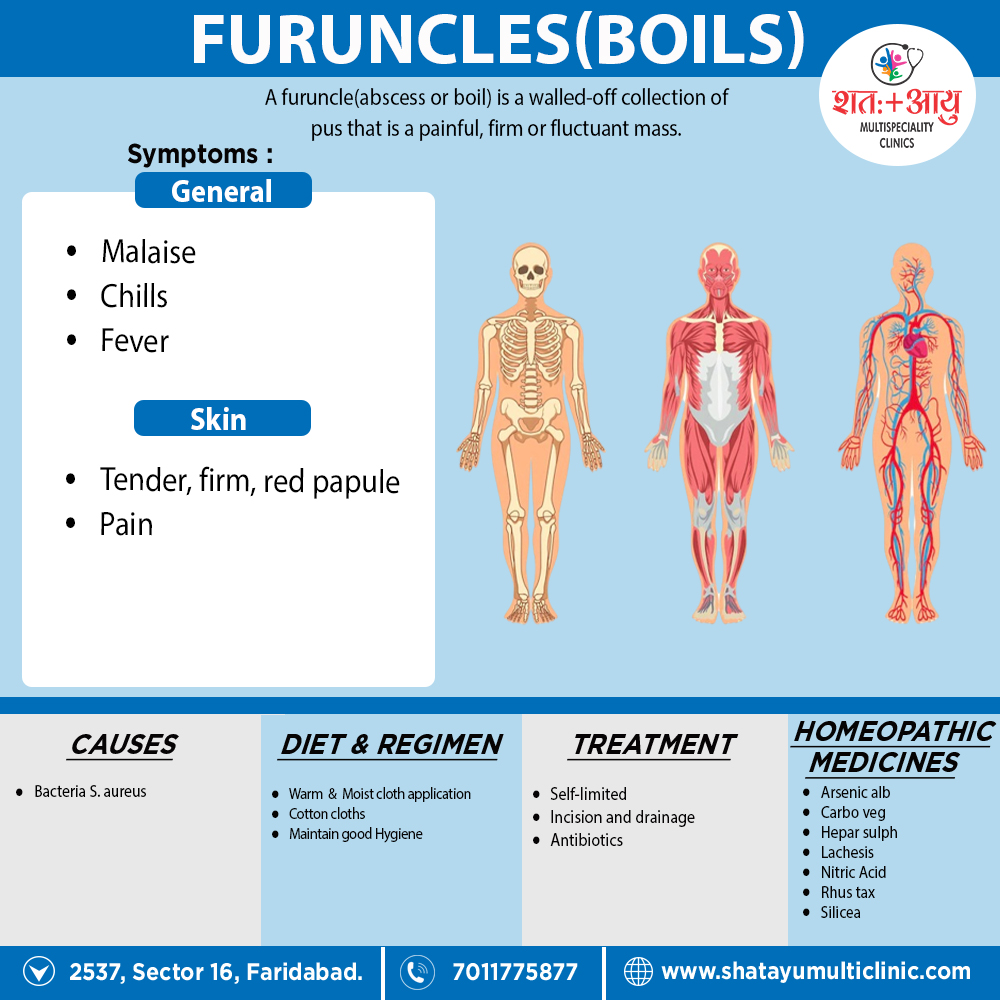Definition
A Furuncles (Boils) is a walled-off collection of pus that is a painful, firm, or fluctuant mass.

A Furuncles (Boils) is a walled-off collection of pus that is a painful, firm, or fluctuant mass.
Cellulites may precede or occur in conjunction with it. An abscess is a cavity formed by finger like loculations of granulation tissue and pus that extends outward along planes of least resistance.
Furuncles are uncommon in children, but increase in frequency after puberty. Furunculosis occurs as a self-limited infection in which one or several lesions are present or as a chronic, recurrent disease that lasts for months or years, affecting one or several family members.
Most patients with sporadic or recurrent Furunculosis appear to be otherwise healthy and have an intact immune system.
Lesions may occur at any site but favor areas prone to friction or minor trauma, such as underneath a belt, the anterior thighs, buttocks, groin, axilla, and waist.
A detailed and thorough history from the patient is necessary. Specific areas of focus when obtaining a history from the patient include history of immuno suppression, family history of Furunculosis, history of contact sports, history of close contact, and recent travel.
Common symptoms of the boil include firm, red, and painful bump with pus filled head.
Laboratory study which is consistent with the diagnosis of boils include the pus culture.
X ray may be performed to detect internal abscess and osteomyelitis.
Other diagnostic studies of boils include blood analysis, urine analysis, and biopsy.
Differential Diagnosis of Furuncles (Boils)
Medical Therapy
Surgery
Homeopathy treats the person as a whole. It means that homeopathic treatment focuses on the patient as a person, as well as his pathological condition. The homeopathic medicines selected after a full individualizing examination and case-analysis.
which includes
A miasmatic tendency (predisposition/susceptibility) also often taken into account for the treatment of chronic conditions.
A homeopathy doctor tries to treat more than just the presenting symptoms. The focus is usually on what caused the disease condition? Why ‘this patient’ is sick ‘this way’?.
The disease diagnosis is important but in homeopathy, the cause of disease not just probed to the level of bacteria and viruses. Other factors like mental, emotional and physical stress that could predispose a person to illness also looked for. No a days, even modern medicine also considers a large number of diseases as psychosomatic. The correct homeopathy remedy tries to correct this disease predisposition.
The focus is not on curing the disease but to cure the person who is sick, to restore the health. If a disease pathology not very advanced, homeopathy remedies do give a hope for cure but even in incurable cases, the quality of life can greatly improved with homeopathic medicines.
The homeopathic remedies (medicines) given below indicate the therapeutic affinity but this is not a complete and definite guide to the homeopathy treatment of this condition. The symptoms listed against each homeopathic remedy may not be directly related to this disease because in homeopathy general symptoms and constitutional indications also taken into account for selecting a remedy.
Homeopathy treats the person as a whole. It means that homeopathic treatment focuses on the patient as a person, as well as his pathological condition. The homeopathic medicines are selected after a full individualizing examination and case-analysis, which includes the medical history of the patient, physical and mental constitution, family history, presenting symptoms, underlying pathology, possible causative factors etc.
A miasmatic tendency (predisposition/susceptibility) is also often taken into account for the treatment of chronic conditions. A homeopathy doctor tries to treat more than just the presenting symptoms. The focus is usually on what caused the disease condition? Why ‘this patient’ is sick ‘this way’. The disease diagnosis is important but in homeopathy, the cause of disease is not just probed to the level of bacteria and viruses.
Other factors like mental, emotional and physical stress that could predispose a person to illness are also looked for. No a days, even modern medicine also considers a large number of diseases as psychosomatic. The correct homeopathy remedy tries to correct this disease predisposition. The focus is not on curing the disease but to cure the person who is sick, to restore the health. If disease pathology is not very advanced, homeopathy remedies do give a hope for cure but even in incurable cases, the quality of life can be greatly improved with homeopathic medicines.
The homeopathic remedies (medicines) given below indicate the therapeutic affinity but this is not a complete and definite guide to the homeopathy treatment of this condition. The symptoms listed against each homeopathic remedy may not be directly related to this disease because in homeopathy general symptoms and constitutional indications are also taken into account for selecting a remedy.
A Furuncles (Boils) is a walled-off collection of pus that is a painful, firm, or fluctuant mass.
References